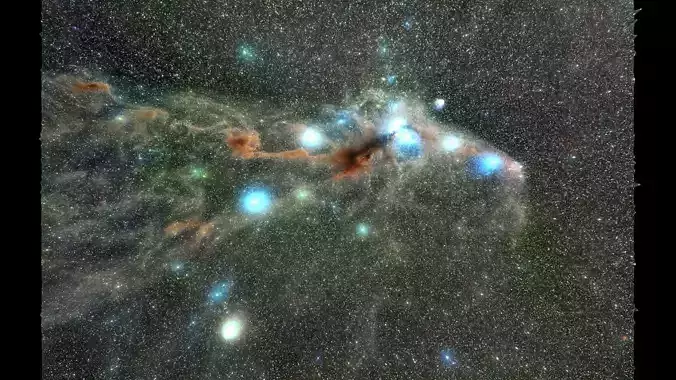1/14
DescriptionCorona Australis is a constellation in the Southern Celestial Hemisphere. Its Latin name means southern crown, and it is the southern counterpart of Corona Borealis, the northern crown. It is one of the 48 constellations listed by the 2nd-century astronomer Ptolemy, and it remains one of the 88 modern constellations. The Ancient Greeks saw Corona Australis as a wreath rather than a crown and associated it with Sagittarius or Centaurus. Other cultures have likened the pattern to a turtle, ostrich nest, a tent, or even a hut belonging to a rock hyrax. Although fainter than its northern counterpart, the oval- or horseshoe-shaped pattern of its brighter stars renders it distinctive. Alpha and Beta Coronae Australis are the two brightest stars with an apparent magnitude of around 4.1. Epsilon Coronae Australis is the brightest example of a W Ursae Majoris variable in the southern sky. Lying alongside the Milky Way, Corona Australis contains one of the closest star-forming regions to the Solar System—a dusty dark nebula known as the Corona Australis Molecular Cloud, lying about 430 light years away. Within it are stars at the earliest stages of their lifespan. The variable stars R and TY Coronae Australis light up parts of the nebula, which varies in brightness accordingly.
NameThe name of the constellation was entered as Corona Australis when the International Astronomical Union (IAU) established the 88 modern constellations in 1922. In 1932, the name was instead recorded as Corona Austrina when the IAU's commission on notation approved a list of four-letter abbreviations for the constellations.[7] The four-letter abbreviations were repealed in 1955. The IAU presently uses Corona Australis exclusively.
CharacteristicsCorona Australis is a small constellation bordered by Sagittarius to the north, Scorpius to the west, Telescopium to the south, and Ara to the southwest. The three-letter abbreviation for the constellation, as adopted by the International Astronomical Union in 1922, is CrA. The official constellation boundaries, as set by Belgian astronomer Eugène Delporte in 1930, are defined by a polygon of four segments (illustrated in infobox). In the equatorial coordinate system, the right ascension coordinates of these borders lie between 17h 58.3m and 19h 19.0m , while the declination coordinates are between −36.77° and −45.52°. Covering 128 square degrees, Corona Australis culminates at midnight around the 30th of June and ranks 80th in area. Only visible at latitudes south of 53° north, Corona Australis cannot be seen from the British Isles as it lies too far south, but it can be seen from southern Europe and readily from the southern United States.
Texture Resolution: 3072 x 2365
REVIEWS & COMMENTS
accuracy, and usability.














